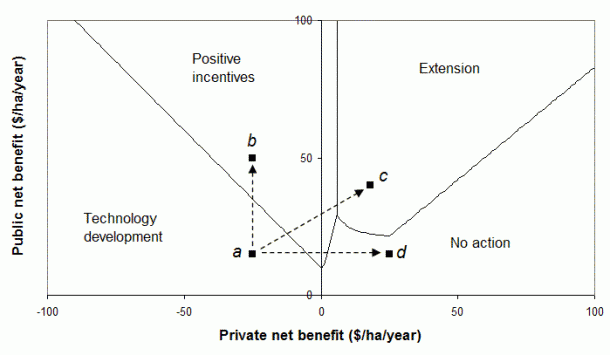79 – Public benefits, private benefits, and technology development
This is the sixth instalment of a series that examines a simple framework for choosing environmental policy instruments, as outlined in PD#73. The framework is based on levels of public and private net benefits of changing land management, and a set of simple rules. This time we focus on the use of technology development.
In PD#73 I showed how a set of simple and reasonable rules can lead to a useful map of efficient policy instruments. The context is an environmental manager considering prospective projects to change land use in particular ways on particular pieces of private land. In the past four Pannell Discussions we have looked in more detail at the individual policy mechanism choices, and refined the map that was presented in PD#73. This article deals with the last of the potential mechanisms: technology development.
In this context, technology development means development of improved land management options, such as through strategic R&D, participatory R&D with landholders, and perhaps provision of infrastructure. Examples could include plant breeding and selection to generate more productive perennial plants, or farming systems research to test and improve management of new plants in an agricultural context.
Figure 1 shows the revised map of efficient policy mechanisms from PD#76. The choice of mechanisms depends on the levels of public and private net benefits from the proposed changes in land management. A particular project to change land use in particular ways on particular pieces of land would be represented by a dot somewhere on Figure 1. Depending on where the various dots lie, different types of policy response are recommended. This section of the map is for cases where public net benefits are positive. It allows for adoption lags and learning costs (see PD#75).
Figure 1. Revised map of efficient policy mechanisms allowing for adoption lags and learning costs.
The reasons for recommending technology development in the lower-left area of the figure are: (a) Private net costs exceed public net benefits, so the management changes required in the project do not yield positive net benefits overall. This means that positive incentives are not appropriate; and (b) Technology development may provide a cost-effective strategy to generate new technologies or may alter existing technologies so that they do yield net benefits overall.
To explain what I mean in (b), here is an example. Suppose that point a Figure 1 represents a project that aims to plant 40% of the area of a watershed to woody perennial plants. The project would generate modest public net benefits per ha (about $15/ha/year in the figure), but it would do so at a net cost of $25/ha/year to private landholders. Without some incentive mechanism, the land-use change would not be voluntarily adopted, and there is no case to introduce an incentive mechanism because, overall, costs would outweigh benefits.
Technology development could be undertaken to develop new woody perennial plants that would be more profitable to farmers than their current land use in the relevant location, while providing at least the same public net benefits. If this technology development was successful, it would move the project to, say, point d. Although the recommendation for the new project would then be “no action”, the profitability of the new woody perennial plants would prompt voluntary adoption of the new plants, probably after a lag during which landholders learned about the technology and gained confidence in it. In this way, the investment in technology development would yield public environmental benefits by enhancing adoption via the mechanism of generating increased profits for landholders.
Alternatively, technology development could attempt to improve the environmental benefits of the technology, moving the project up to, say, point b. For example, this might involve developing new harvesting systems so that the woody perennials provided better habitat for wildlife. If the improvement was substantial enough, it would then be worth using positive incentives to get landholders to adopt the new management option. At point b, the incentives required to compensate growers for adopting would be less than the public net benefits from the land-use change itself.
If both dimensions could be improved, we might move the project to, say, point c, where extension is recommended, as private net benefits are positive enough for incentives to be unnecessary – landholders would adopt the change reasonably rapid without them.
The merits of technology development as a strategy for the indicated set of projects depends on a set of additional factors that cannot be illustrated on this diagram, including: the likelihood of R&D delivering sufficiently improved technologies, the time lag until delivery of improved technologies, and the cost of the R&D. Overall, R&D does have an outstanding track record of delivering improved technologies for agriculture, and in my view, it has been neglected as a strategy for investment in environmental programs. A particular attraction of technology development is its potential to prompt adoption of changed practices over large areas, without the need for incentives.
Figure 1 is perhaps a little misleading in that the role of technology development would not be limited to the indicated area; it could be an option in any part of the diagram, depending on the opportunities and the costs. It is particularly indicated as the recommendation for the lower-left area of Figure 1 because the more direct instruments (positive incentives and extension) are not suitable for that area, and yet much (probably most) agricultural land falls within this category, if we are thinking about some of the main resource degradation problems. Also, given the past neglect of technology development as a strategy, there are likely to be many unexploited opportunities for cost-effective investment in that area.
David Pannell, The University of Western Australia
